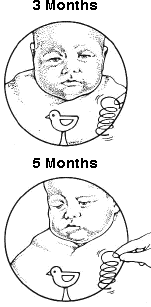DVDs, Books, and other Materials about Child Development and Children with Disabilities |
Home Page Curriculum Vitae Products by Topics FAQs Free Downloads Resource Links Order Info Contact Us |
FREQUENTLY ASKED QUESTIONS (FAQs) ABOUT VISUAL DEVELOPMENT
Q. Why do some children avoid
watching their hands or look at them only briefly?
A. Task
analysis is necessary to discover the cause of poor visual monitoring of
hands, since there are so many possible reasons. Many children with
multiple disabilities have poor grading of neck muscles for head
control. They must maintain the head totally erect or it will flop into
flexion. Thus, fixation on their hands or objects is usually fleeting.
Long-term goals can include improving head control, but short-term
intervention must provide environmental adaptations such as head support
and appropriate positioning of objects so eyes can watch hands. Some
children's eyes, however, are influenced by the flexion/extension
components of the Doll's Eye Responses, involuntary reflexes that should
be integrated by 3 months. If not, when the neck flexes downward, the
eyes remain up or are delayed in moving down with the head. Copying from
the chalkboard to a paper on the desk would be more difficult and
delayed. The integration of this reflex can be accelerated if the child
has plenty of practice with the neck flexion/extension movements in a
functional but less stressful context, such as a game of identifying
objects in far space and drawing a picture on a paper in near
space.
 Q. How can we decrease distractibility problems in
the classroom?
Q. How can we decrease distractibility problems in
the classroom?
A. Many children are easily distracted by any
visual stimulus, especially moving objects, and are unable to maintain
attention. To understand fixation, or visual grasp (the ability to keep
the eyes on a target), we need to review its developmental process. The
newborn's eyes are usually in constant motion, roving through the
immediate environment, with only one eye able to align and immobilize
briefly on an object presented in a specific spot. By one month, the
infant's first true fixation is a vague stare at the surroundings, and
fixation on Mother's face is still brief. By 3 months, the baby can
maintain fixation on a stationary target unless distracted by a more
compelling moving target. Not until 5 months can a moving target be
ignored for an interesting stationary one. I believe visual
distractibility is a sign of delayed development. We can help these
children by analyzing and inserting all the necessary motor components,
and/or by conditioning them to focus on relevant stationary targets
during attempts to distract with moving targets. For example, we can ask
a child to build the tallest block tower possible, while we try to
bother him with a squeezie toy frog hopping in all visual
fields.
Q. Should we try to help a child move eyes separately
from head for faster reading?
A. It depends. Infants don't
begin to move eyes separately from head until 5 or 6 months, when the
rotational components of the Doll's Eye Responses are integrated and
head control has been perfected. If those and other elements are in the
process of development, it may be best to allow the child's visual
development to proceed normally, although delayed, because visual
motivation stimulates head control. If, however, we are reasonably sure
that a child with severe disabilities may never gain sufficient head
control, we would provide adaptive equipment and positioning to
stabilize the head. The eyes could then move very precisely to operate
an augmentative communication system.
Q. What can we do about
children with cortical visual impairment (CVI) who seek self-stimulating
visual displays, including repetitive hand movements in front of their
faces?
A. Normal infants go through developmental stages of
attraction to specific stimuli, such as black and white patterns, bright
colors, moving targets, targets with internal movement and/or sound
properties, diffuse light, focal light, and of course, faces. These
patterns are gradually linked to concrete objects that they are able to
handle and explore, categorize with cognitive awareness, and label
through language. The more mobile the developing child, the more
opportunity that child has to seek and receive a variety of visual and
tactile input. People with cognitive, visual, and/or mobility
impairments still have strong needs for that sensory input followed by
motor output. Since their developmental process is interrupted, they get
stuck using a few stereotypic patterns to satisfy those needs. Our
intervention depends on determination of specific developmental levels
and sensory motor needs of each individual. For example, children with
very low vision may need manual assistance in exploring the tactile
attributes of accessible objects, concurrently with learning their names
and functional uses. By offering more choices for gaining meaningful
sensory information, we help these children expand their repertoire of
socially acceptable behaviors. An appropriate sensory diet could address
ways of providing proprioceptive and vestibular input as well as
tactile, through selected activities that are age-appropriate and
related to occupations of childhood.
Adapted from: Erhardt, R.P. (May 18, 1998). Visual Function Series #1. Visual development: Answers to some common questions. ADVANCE for Occupational Therapists, 14(20), 19-20.
You are welcome to copy and paste this page for your own clinical or educational use.
*
Glossary of Vision Terms
* Visual
Function